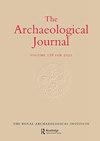From field to suburb: investigating a planted monastic settlement at Barnwell, Cambridge
IF 0.8
0 ARCHAEOLOGY
引用次数: 0
Abstract
ABSTRACT At the beginning of the thirteenth century a planted development was established outside the gates of the Augustinian Priory at Barnwell, Cambridge. Although dislocated from the urban core by a kilometre of open fields, the new settlement nevertheless expanded rapidly; by the close of the thirteenth century, it housed almost one-sixth of the town’s overall population and had attained the legal status of a suburb. Utilising a combination of archaeological evidence and historical sources, the settlement’s origins, development and wider context are explored. In particular, its ‘suburban’ character is examined via a comparison of patterns of refuse disposal undertaken at a variety of sites situated elsewhere across Cambridge and its hinterland. Despite its early success, during the fifteenth century Barnwell’s population began to decline. The settlement’s diminution continued into the post-medieval period, until the area was eventually transformed via intensive speculative development into Cambridge’s largest nineteenth-century suburb.从田野到郊区:调查剑桥巴恩韦尔的一个种植修道院定居点
13世纪初,在剑桥巴恩韦尔的奥古斯丁修道院大门外建立了一个种植开发区。尽管与城市核心相隔一公里的开阔地带,新的定居点仍然迅速扩张;到13世纪末,它几乎容纳了该镇总人口的六分之一,并获得了郊区的法律地位。结合考古证据和历史资料,探索了该定居点的起源、发展和更广泛的背景。特别是,它的“郊区”特征是通过在剑桥及其腹地的其他地方的各种地点进行的垃圾处理模式的比较来检查的。尽管早期取得了成功,但在15世纪,巴恩韦尔的人口开始下降。该定居点的缩小一直持续到后中世纪时期,直到该地区最终通过密集的投机开发转变为剑桥最大的19世纪郊区。
本文章由计算机程序翻译,如有差异,请以英文原文为准。
求助全文
约1分钟内获得全文
求助全文

 求助内容:
求助内容: 应助结果提醒方式:
应助结果提醒方式:


